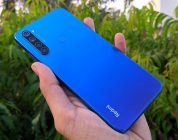Apple’s iPhone 13 (starting at $ 799) is a battery life beast, with far greater longevity than previous mid-range smartphones. While we appreciate the iPhone 13 mini’s larger pocket capacity, the unimpressive sales of the iPhone 12 mini taught us that most people prefer a long battery life to a small form factor. So while other upgrades from the older generation are almost unnoticeable here, the battery surge is so profound that it’s definitely worth the $ 100 premium over a standard-size iPhone 12. And if you’re upgrading from an older iPhone, you’ll find many welcome improvements in camera power and quality. That makes the iPhone 13 the best choice for most buyers, as well as the winner of our Editors’ Choice award.
Design: subtle improvements
The iPhone 13 looks a lot like the iPhone 12. At 5.8 by 2.8 by 0.3 inches (HWD) and 6.1 ounces, it’s roughly the same size as the iPhone 12 but a third of an ounce heavier. Due to the slightly different position of the side buttons, some cases designed for the older model work, and some do not.
There is a difference to notice in the front and another in the back. On the front, the “notch” at the top of Face ID is slightly smaller, 20% smaller, according to Apple. The two camera lenses are slightly larger and are staggered diagonally rather than stacked vertically at the back.
iPhone 12 vs. 13 notches
The iPhone 13 (front) has a smaller notch than the iPhone 12 (rear)
There are five color options, including blue, pink, red, “midnight” (a blue so dark it can be read as black), and “starlight” (a subtle off-white, like an eggshell).
Like the iPhone 12, the iPhone 13 has a gorgeous 6.1-inch 2,532-by-1,170-pixel OLED display with a wide color gamut and Apple’s True Tone color management. Apple says typical brightness is now 800 cd / m2 compared to 625 cd / m2 for the iPhone 12. When looking at it, I can’t see a difference; We will rely on DisplayMate Labs testing to verify that number when the results are published.
iPhone 12 vs. 13 back
The iPhone 13 (right) has cameras arranged diagonally, unlike the iPhone 12 (left) (Photo: Molly Flores)
One of the differences between the standard iPhone 13 and iPhone 13 Pro models is that the 13 has a 60Hz screen, while the Pro phones have 120Hz screens. If you’ve never experienced a 120Hz display, this won’t be a big deal. 60Hz displays have been standard for many years, and the iPhone 13’s display is fluid and smooth.
But I’ve been using 120Hz displays on OnePlus and Samsung phones for almost a year now, and the reduction to 60Hz seemed a bit disconcerting to me; Scrolling through the web pages, I felt like they were tearing a bit as I read the news articles. But again, unless you’re used to using a recent flagship phone, you probably won’t think twice.
Apple’s A15 CPU is manufactured using the same 5nm process as the previous A14. Apple says its 6-core CPU and 4-core GPU have the fastest performance of all time.
I only saw an 8% improvement in single-core CPU performance and a 13% improvement in GPU performance compared to the iPhone 12. However, I saw a much larger improvement. In the real-world Basemark web browser performance test. Which jumped from 766.86 to 1042.93 as the phone sped up web page loads.
The iPhone 13 Pro and the iPhone 13 Pro Max are not so different from each other. For reference, last year saw Max get the best camera system. They’re the same now, so it’s just about screen size and battery life.
Battery duration
Apple claims that the iPhone 13 mini can last for 13 hours when playing a video stream, and the iPhone 13 is rated at 15 hours. It’s a huge leap forward to the iPhone 13 Pro, which claims to offer 20 hours, and the iPhone 13 Pro Max promises a whopping 25 hours.
This is due to several things, like a more efficient processor, the ProMotion display on Pro phones (we’ll get to that soon), and most importantly, bigger batteries. Apple has realigned the internals of all phones to make room for more battery capacity. When it comes to lithium ion batteries, physics laws cannot be changed, but they can be applied by brute force.
A15 bionic
That most efficient processor is the A15. Apple hasn’t made many specific performance claims about how the A15 compares to last year’s A14, but we do know that the new SoC has a 6-core CPU with two performance cores and four efficiency cores, one 5-core (in Pro models) or 4-core GPU (on normal iPhone 13 models) and 16-core NPU (which is “neural processing unit,” for hardware-accelerated machine learning).
Commercial
Performance doesn’t seem to be the main focus of Apple’s latest iPhone update, which is fine because last year’s phones were already by far the fastest on the market, and no one else has matched them. But we will share our benchmark results later in the review.
Dimensions
The iPhone 13 measures 5.78 × 2.82 × 0.3 inches, or 146.7 × 71.5 × 7.65 millimeters. The iPhone 13 mini is 5.18 × 2.53 × 0.3 inches or 131.5 × 64.2 × 7.65 millimeters.
That makes them a bit thicker than their predecessors. The iPhone 13 mini is still adorably small, and it’s great to see a one-handed phone with so many features again in Apple’s lineup. If only we could be sure that it would still be available next year.
The fact is, Apple’s tight integration between hardware and software always leads to new iPhones performing flawlessly, at least initially. Years will pass when they get into trouble. Nothing I could throw at the iPhone 13 in its first week fazed him, from Microsoft Office to Genshin Impact.
See how we test phones.
The iPhone 13 and 13 mini have the same performance. Both the 13 Pro and Pro Max add a fifth GPU core, which also led to disproportionately better test performance in our benchmarks. But if applications work fine with all four GPU cores, why do you need the fifth core? It’s for the 120Hz display, one of the differentiating features offered by the more expensive Pro series.
We’ve got a lot more details on performance in our full iPhone 13 benchmarking story.
searching the web
Battery: that’s why you’re here
Apple made a big leap in battery management and capacity with the iPhone 12 series, but much of that was lost to real-world use with the transition to power-hungry 5G. The iPhone 13 series straightens the boat, delivering true full-day battery life with the base model iPhone 13 and two-day battery life with the 13 Pro.
In this case, it is not about the size of the battery. We do not have the technical details of the battery capacity of the iPhone 13, but it is not much larger than that of the 12. But the new A15 processor and the X60 modem seem to be much more efficient than the A14 and X55 of the iPhone 12 series. Leading to much longer video playback time and much longer real-world usage time.
Now even the iPhone 13 mini is better than the standard iPhone 12. But there is still a big difference between the 13 mini and the standard 13, and I think that is the main reason why you will end up wanting to buy a standard 13.
After using the iPhone 13 for a weekend as my primary device, I felt no battery anxiety. It was almost always ready to go, unlike my Samsung Galaxy Z Fold 3, frequently running low. That shows the confluence of Apple’s efficient hardware and software. One of Apple’s “secrets” over the years has been that iPhones use much less battery power while on standby than Android phones.
The phone charges somewhat quickly, as does the iPhone 12. If you connect its Lightning port to a 20-watt USB-C PD power adapter, you can get relatively fast charging speeds; It also supports 7.5W Qi wireless charging and 15W MagSafe magnetic charging introduced with the iPhone 12 series.




